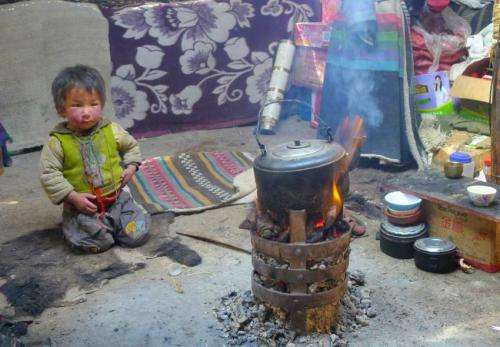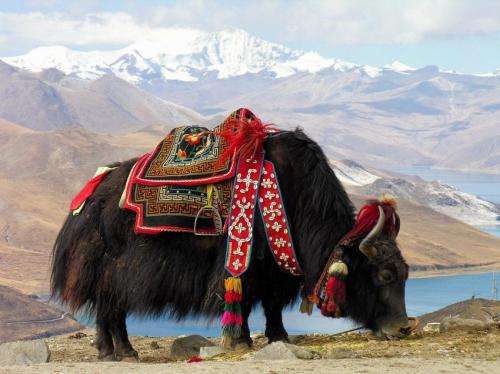Yak dung burning pollutes indoor air of Tibetan households

Tibet, the highest region on Earth and one of the most remote, is associated with vivid blue skies and the crystal clear air of the Himalayas. During the long cold season, however, the traditional nomadic people spend much of their time in snug dwellings where they cook and stay warm by burning yak dung. Their indoor air can be filled with dangerous levels of fine particulate matter, including black carbon, a new study finds.
The journal Atmospheric Environment published the research, led by Eri Saikawa, an assistant professor in the Department of Environmental Sciences at Emory University and in the Department of Environmental Health at the Rollins School of Public Health.
"Indoor air pollution is a huge human health problem throughout the developing world," Saikawa says. "In a cold region like Tibet, the impact on individuals could be even greater because they spend so much time indoors and try to keep their homes as air tight as possible."
Globally, the World Health Organization (WHO) estimated that 4.3 million people died prematurely in 2012 due to indoor air pollution from traditional stoves, fueled by coal, wood, dung or crop waste. In comparison, WHO estimated that outdoor air pollution was linked to 3.7 million deaths that year.
Tibet is situated on a plateau northeast of the Himalayas in China. For centuries, nomadic people there have herded yaks, large, long-haired relatives of cattle. Yaks work as pack animals and supply meat, milk, and fiber for fabrics. They also generate heating fuel in the form of dung.
Previous studies had looked at indoor air quality in Tibet during the summer season. Saikawa and her team wanted to investigate indoor emissions during the colder months.
In March of 2013, Qingyang Xiao, a graduate student in Rollins School of Public Health, traveled to the Tibetan region of Nam Co (which means "heavenly lake") to gather the data. About 4,500 residents live in the region, at an altitude of 4,730 meters.
Xiao used battery powered aerosol monitors to measure indoor concentrations of fine particulate matter, or particles 2.5 micrometers in diameter or smaller, which consists mainly of black carbon and organic carbon. She recorded the measurements in six households with different living conditions and stove types. Yak dung was the main fuel for cooking and the only fuel for heating.

The results showed that the average concentrations for black carbon and fine particulate matter were nearly double those reported by some similar studies of households in areas of lower altitude and warmer climates, such as India and Mexico.
The Tibetan homes included four traditional tents and two simple stone houses. Both the tents and the houses had only one room where all of the family members slept, ate and cooked.
Three of the families used traditional open stoves without chimneys, and three had added chimneys to their stoves. A simple house with a chimney had the lowest indoor concentrations. This household lived on tourism and used liquefied petroleum gas (LPG) for cooking.
However, a stone house with a chimney had the highest black carbon concentrations.
"That was surprising," Saikawa says. "It shows that it is misleading to think that having a chimney will always improve the situation, unless you can be sure that the home is ventilated correctly and that you have proper air flow within a dwelling."
Xiao also surveyed members of 23 households on energy use and awareness of indoor air pollution. The families said they spent an average of 16 hours a day indoors during the colder months of the year.
Seventy percent of those surveyed said that they were aware of the health problems associated with indoor air pollution, and some of them did not have the economic means to purchase a chimney. (The average annual income per household is less than $900 a year, and a chimney costs around $60.)
The moisture content of the yak dung is another key factor in the emission levels, Saikawa says. After a rain or snowfall, the piles of uncovered dung are moist, leading to incomplete combustion and more emissions of fine particulate matter due to increased organic carbon by smoldering.
"It's a complicated issue," Saikawa says. "It's much more than just a science problem. You have to understand how people live if you want to help find solutions to improve their lives."
The Emory research team, including students from environmental sciences and the Rollins School of Public Health, is expanding on the small sample of households in this initial study. They are investigating indoor emissions in other areas of Tibet and plan to link these measurements to a biomarker study based on blood samples of people living in the households.
Saikawa, a specialist in atmospheric chemistry, is also studying levels of black carbon emissions in the outdoor environment generated by the burning of biomass fuels like yak dung.
Black carbon absorbs heat in the atmosphere and reduces the ability to reflect sunlight when deposited on snow and ice. Its impact is greatest at high altitudes. "Black carbon emissions from burning biofuel such as yak dung have not been quantified before in the atmosphere of the Himalayas," Saikawa says. "We know that many Himalayan glaciers are melting rapidly, and our work suggests that more black carbon is getting deposited on them than previously thought."
She hopes to eventually work with Georgia Tech engineer Jonathan Colton to develop gasifier cook stoves that would burn yak dung in a more efficient matter, producing fewer emissions. The stove would need to be portable, to suit the nomadic way of life, affordable for the Tibetans and simple to maintain.
"We want to use our data to make the world a better place," Saikawa says. "The ultimate goal is to reduce pollution from biomass fuels in ways that benefit human health and reduce the climate impact."
More information: www.sciencedirect.com/science/ … ii/S1352231014009327
Journal information: Atmospheric Environment
Provided by Emory University


















